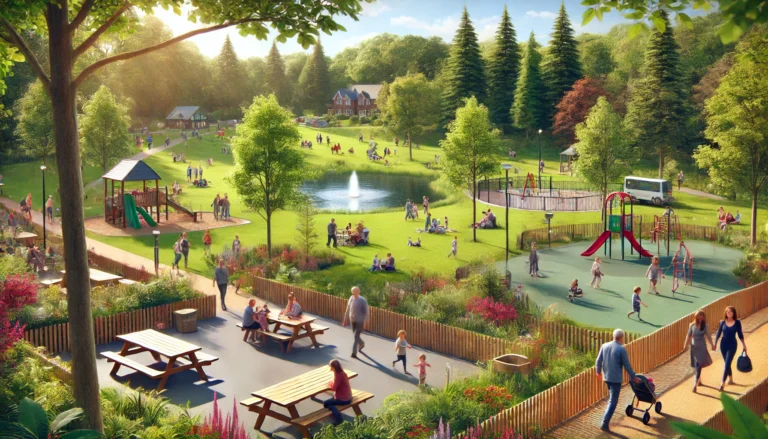Local government leadership
Building Trust Within the Community
Crafting trust within a community isn’t just important—it’s absolutely vital for governance that actually works. Local leaders, take note! Transparency should be your guiding star in decision-making. Think about it: when you communicate openly about what’s on the table and actively invite feedback from the public, you’re not just sharing information; you’re weaving a tapestry of inclusion. Residents who feel genuinely heard, whose concerns are taken to heart—this is how you strengthen the ties between citizens and their representatives! It’s this very relationship that becomes the bedrock for rolling out policies that truly resonate with what the community needs and dreams of.
But wait, there’s more to building trust than just good vibes—it requires accountability too! Local officials have a duty to keep everyone in the loop about how community projects are progressing and where resources are being directed. These practices do double duty: they inform while also nurturing a culture steeped in responsibility. When local governments step up and show they’re accountable? That sparks confidence in their commitment to act in favor of the community’s best interests. And let me tell you, that kind of trust is essential for rallying residents around civic initiatives and boosting engagement like never before!
Transparency and Accountability Measures
Effective local government dances on the fine line of transparency and accountability, intricately woven to earn the trust of its constituents. When robust measures are put into play, decision-making processes materialize before the public eye—visible, understandable, and open for interpretation. The regular unveiling of detailed reports—budgets, expenditures, project outcomes—creates an atmosphere ripe with openness. But it doesn’t stop there; inviting citizen feedback through vibrant public forums and engaging surveys amplifies the legitimacy of municipal actions in a way that mere announcements cannot.
Ah, but we must not overlook accountability mechanisms! They stand as crucial pillars supporting ethical governance. By establishing clear pathways for reporting misconduct or mismanagement, citizens find themselves empowered to hold their local leaders accountable—a powerful dynamic indeed! The creation of oversight bodies or independent audits acts like a watchdog over officials’ adherence to established policies and regulations. These practices do more than just deter corruption; they echo a resounding commitment from local leaders to genuinely serve the public interest.
As this intricate tapestry of trust is painstakingly woven through these practices, community members begin to engage more deeply; they invest not just in governance but also in each other’s voices within this democratic symphony.
The Significance of Collaborative Governance
In the intricate web of societal dynamics, collaborative governance emerges as a vibrant tapestry where diverse stakeholders intertwine their efforts to tackle shared dilemmas and craft effective solutions. Imagine a bustling marketplace of ideas—local government officials mingling with community organizations and engaged citizens, all participating in spirited dialogues that spark mutual understanding and forge a collective sense of responsibility. Each stakeholder brings their own distinct viewpoint to the table, enriching the decision-making process and cultivating an empowering sense of ownership among those who feel the impact of policies and initiatives.
Today’s societal challenges are anything but straightforward; they demand approaches that are as multifaceted as they are imaginative. Collaborative governance acts like a bridge over turbulent waters, encouraging resource sharing while harnessing the unique strengths found within various entities. This synergy not only births innovative solutions but also constructs comprehensive strategies aimed at tackling complex issues head-on—think public health crises or economic upheavals—that local governments strive to manage effectively. In this cooperative landscape, forming strategic partnerships is crucial; it enhances service delivery while fortifying community resilience. Ultimately, such collaboration ensures that every voice resonates within the governance arena, cherished and acknowledged in its rightful place.
Fostering Partnerships with Nonprofits and Businesses
Local governments are increasingly waking up to a powerful truth: forging robust partnerships with nonprofits and businesses can be the key to supercharging community development. These dynamic collaborations harness the distinct strengths inherent in each sector, conjuring a synergy that tackles local challenges head-on with greater efficacy. Nonprofits often bring specialized expertise and grassroots connections—think of them as the community’s pulse—while businesses inject resources and keen insights into economic currents. Together, they’re poised to roll out programs that uplift society, from initiatives aimed at enhancing education and health to those championing environmental sustainability.
But there’s more! Engaging these external allies cultivates a profound sense of shared responsibility among all stakeholders involved. It empowers local governments to access innovative solutions and diverse viewpoints, weaving governance into something far more responsive and inclusive than before. For these partnerships to thrive, establishing clear communication channels alongside mutual objectives is absolutely crucial. As local leaders strive for vibrant communities, aligning the resources and expertise from nonprofits with those of businesses becomes not just important but essential in addressing complex issues while sparking transformative change!
Training and Development for Local Leaders
Investing in the training and development of local leaders isn’t just important; it’s essential for nurturing a robust governance framework. Picture this: a medley of workshops and programs designed to sharpen critical skills—think public speaking, conflict resolution, strategic planning. These initiatives don’t merely equip leaders; they arm them with the very tools needed to tackle the multifaceted challenges their communities face daily. And let’s not overlook mentoring! The transfer of knowledge from seasoned veterans to up-and-coming leaders creates a ripple effect that fosters individual growth while reinforcing the entire leadership structure within local government.
But wait—there’s more! Tailored development programs can delve deep into the unique needs of diverse communities, ensuring that leaders are not only aware but also adept at being culturally and contextually responsive. Imagine sessions focused on equity, inclusion, and community engagement; these do more than educate—they cultivate an atmosphere where leaders are primed to effectively serve all constituents. By placing a premium on continuous education, local governments have the power to nurture a new wave of visionary leaders ready to innovate and spearhead positive change in their neighborhoods.
Essential Skills for Effective Governance
Navigating the intricate landscape of effective governance demands a rich tapestry of skills, one that equips local leaders to tackle the distinct challenges their communities face. At the heart of this endeavor lies critical thinking—a cornerstone that empowers leaders to dissect complex scenarios and make well-informed choices amidst uncertainty. But wait! It doesn’t stop there; strong communication skills are equally paramount. Elected officials and administrators must not only articulate policies and initiatives with clarity but also tune in actively to the concerns echoing from their constituents.
Moreover, let’s not overlook emotional intelligence—an essential ingredient for nurturing fruitful relationships among all stakeholders involved. Leaders who possess this quality can deftly maneuver through conflicts and foster consensus, which is crucial for collaborative ventures. And then there’s adaptability, another vital asset that allows leaders to pivot gracefully in response to shifting community needs and unforeseen hurdles. Together, these competencies weave a sturdy foundation for vibrant and impactful local governance, where every decision echoes with purpose!
Engaging Youth in Local Governance
Ah, the youth—those vibrant sparks of our community! They embody a crucial slice of society, infusing local governance with fresh ideas and innovative viewpoints that can turn the mundane into the extraordinary. When we invite young people to take part in decision-making, it’s more than just ticking a box; it ignites a sense of civic duty and ensures their hopes and worries are seen and heard. Imagine programs designed to boost participation—they don’t just tweak public policies; they resonate across demographics, crafting an atmosphere rich in inclusion and representation.
Consider initiatives like youth councils or advisory boards: these aren’t merely platforms; they’re dynamic arenas where youthful voices echo with impact. Here, teens and young adults engage directly with local leaders, unlocking insights into how government really operates while honing essential skills for future leadership roles. By pouring resources into programs that empower this energetic demographic, local governments aren’t just investing in today—they’re nurturing tomorrow’s engaged citizens ready to confront community challenges head-on and champion sustainable development. What a powerful ripple effect that could create!
Programs to Inspire Future Leaders
Engaging the youth in the whirlwind of political processes—it’s not just a good idea; it’s absolutely essential for nurturing effective local governance that can stand the test of time. Imagine programs crafted to ignite the spark in future leaders, creating a dynamic pipeline brimming with informed, passionate souls eager to step into government roles! These initiatives are far from mundane; they often burst forth with workshops, mentorship opportunities, and hands-on civic engagement projects—each one a gateway for young people to dive deep into the intricate dance of local decision-making.
Picture this: by immersing them in real-world scenarios, these participants aren’t merely observers—they’re active players honing critical thinking skills while grappling with genuine community issues. The thrill of tackling problems head-on transforms their understanding and equips them with invaluable experience!
And let’s not forget—the backing from local governments, educational institutions, and community organizations supercharges these programs. Collaborations become catalysts that unlock resources like inspiring guest speakers, intensive leadership training sessions, and eye-opening internships. Through such vibrant partnerships, youth gain insights from seasoned leaders who offer guidance that fosters an electric atmosphere ripe for active citizenship.
As these young individuals masterfully navigate the labyrinthine complexities of governance—a process filled with twists and turns—they emerge more than ready to embrace leadership roles. In doing so, they bring innovative ideas and fresh perspectives that ripple through their communities like a refreshing breeze on a hot summer day!
| Program Name | Target Age Group | Activities Offered | Duration | Collaborating Organizations |
|---|---|---|---|---|
| Youth Civic Leadership Program | 14-18 years | Workshops, Mentorship, Community Projects | 6 months | Local Government, NGOs |
| Future Leaders Academy | 16-24 years | Leadership Training, Internships | 1 year | Universities, Community Colleges |
| Engage Young Leaders | 12-18 years | Hands-on Projects, Networking Events | 3 months | Educational Institutions, Youth Organizations |
| Teen Government Institute | 15-19 years | Civic Engagement, Public Speaking | 4 months | State Legislature, Civic Groups |
The Future of Local Government Leadership
Local government leadership is navigating a dynamic and ever-shifting terrain, propelled by the relentless march of technology and the kaleidoscope of changing demographics. Leaders now find themselves at a crossroads where mastering digital tools becomes imperative—not just for service delivery but to truly engage with citizens in meaningful ways. The allure of new technologies, from artificial intelligence to data analytics, beckons with promises of sharper decision-making and streamlined operations. Yet, this metamorphosis demands an unwavering dedication to perpetual learning and nimbleness from local leaders; staying relevant amidst such rapid change is no small feat.
Moreover, as communities blossom into vibrant tapestries of diversity, local leaders are called upon to champion inclusive governance practices that resonate across all spectrums. Inviting a wider array of voices into the decision-making fray enriches representation and ensures that every community member’s needs echo through the halls of power. Building bridges with diverse stakeholders—especially those often relegated to the margins—can spark innovative solutions that genuinely mirror what the community desires. As these leaders chart their course through tumultuous waters, their prowess in connecting with others and fostering collaboration will be pivotal in shaping effective governance outcomes.
Adapting to Technological Advances
The infusion of technology into the workings of local government isn’t just a minor upgrade; it’s like throwing a digital lifeline that boosts efficiency and responsiveness to dizzying heights. Imagine municipalities harnessing the power of data analytics—suddenly, they’re not just reacting but anticipating community needs with laser-like precision! Resources can be allocated with uncanny effectiveness, services streamlined as if by magic. Local leaders find themselves on a tightrope, needing to stay nimble and in-the-know about the ever-evolving tech landscape that holds promises for better governance, deeper citizen engagement, and shining transparency.
But wait—there’s more! Embracing these technological marvels doesn’t merely solve today’s issues; it equips local governments to tackle tomorrow’s challenges head-on. A spotlight on digital literacy becomes essential; staff and officials must wield their skills like swords against an advancing tide of complexity. And let us not overlook cybersecurity—a fortress protecting sensitive information while simultaneously bolstering public trust like never before. By elevating technology to a cornerstone of their governance strategies, local governments don’t just keep pace—they position themselves as trailblazers ready to meet the relentless demands of our increasingly digital world!
- Implement training programs for staff to enhance digital literacy and tech proficiency.
- Invest in robust cybersecurity measures to safeguard sensitive data from threats.
- Utilize data analytics to identify and proactively address community needs.
- Foster collaboration between tech companies and local governments for innovative solutions.
- Regularly update technology and infrastructure to keep up with advancements.
- Engage citizens through user-friendly digital platforms for feedback and participation.
- Monitor emerging technologies to continuously improve governmental operations and services.
Conclusion
Local government leadership stands as a cornerstone in the intricate mosaic of community life, deftly navigating the myriad challenges that arise. As these leaders strive to forge trust and foster engagement among an ever-diverse array of constituents, their unwavering dedication to transparency and accountability becomes not just important—it morphs into a vital lifeline for cultivating authentic relationships. The essence of collaborative governance cannot be overstated; it highlights the dynamic interplay between government entities, nonprofits, and businesses—together they can spark innovative solutions to urgent problems.
Peering into the horizon ahead, local government leaders are called upon to embrace a spirit of adaptability and relentless learning. With each twist in the evolving narrative of governance driven by technological revolutions, arming these leaders with essential skills emerges as paramount for ensuring that governance remains both effective and responsive. By committing resources to enhance professional development for local leaders while actively engaging youth in governance initiatives, communities can breathe life into a vibrant political culture—a fertile ground where tomorrow’s trailblazers may flourish.







